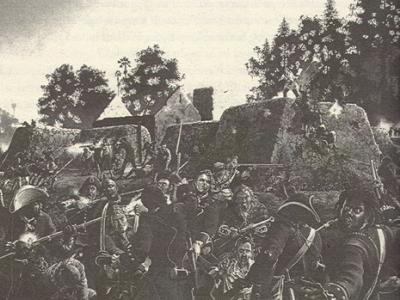
Fort Mose, Fla.:The First 'Emancipation Proclamation'
Courtesy of Black Past
Founded in 1738, Fort Mose,located just north of St. Augustine , is the United States ' first free black settlement. Amid the fight for control of the New World, Great Britain , Spain and other European nations relied on African slave labor. The king of Spain issued an edict: Any male slave of the British colonies who escaped to the Spanish colony of Florida would be set free -- as long as he declared his allegiance to Spain and the Catholic Church. The settlement was abandoned when the British took possession of Florida in 1763.
Captions by Monée Fields-White
#2
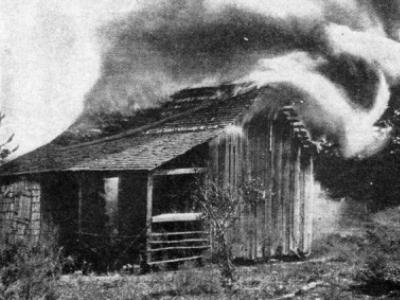
Rosewood, Fla.: A Massacre That Won't Be Forgotten
Courtesy of The Real Rosewood Foundation
Rosewood, established in 1870, was the site of what could be considered one of the worst race riots in U.S. history. By 1915 it was a small, predominantly black town -- with a population of just slightly more than 300. On New Year's Day in 1923, a young white woman claimed that a black man sexually assaulted her; Rosewood was destroyed by a band of white men searching for the alleged suspect. The number of those killed is still unknown.
#3
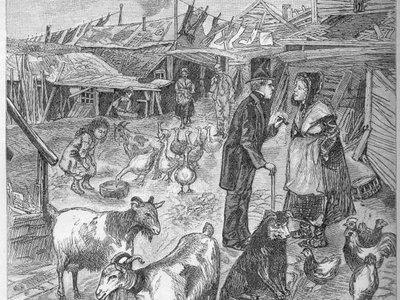
Seneca Village, N.Y.: Taking a Stroll Through History
Courtesy of The New-York Historical Society
Located between 82nd and 89thstreets and Seventh and Eighth avenues is Manhattan 's first community of prominent black property owners. The New York State census estimated that about 264 residents lived in Seneca Villagebetween 1825 and 1857. The area consisted of three churches, a school and several cemeteries. All was razed -- and the history erased -- with the development of Central Park.
#4
Five Points District , N.Y. : High Stakes in Lower Manhattan
Courtesy of The New-York Historical Society
Today we know it as Wall Street, but from the 1830s to the 1860s, this area was the site of Manhattan 's first free black settlement. Located on the five-cornered intersection of what were then Anthony , Cross, Orange and Little Water streets, it also became known as a notorious slum, with its dance halls, bars, gambling and prostitution. Many blacks fled the area to escape the draft riots of 1863.
#5
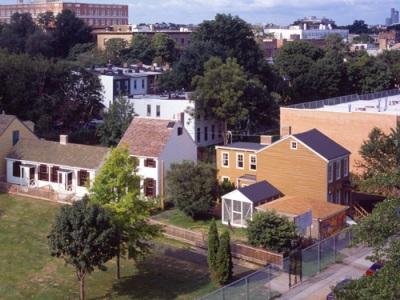
Weeksville, N.Y.: A Refuge for Southerners and Northerners
Courtesy of The Weeksville Heritage Center
What is now Bedford-Stuyvesant in Brooklyn , N.Y. , Weeksville was the second-largest community for free blacks prior to the Civil War. James Weeks, a freed slave, purchased a significant amount of land from Henry C. Thompson, another freed slave. Weeks sold property to new residents, who eventually named the community after him. It thrived over the years, becoming home to both Southern blacks fleeing slavery and Northern blacks escaping the racial violence and draft riots in New York and other cities.
#6
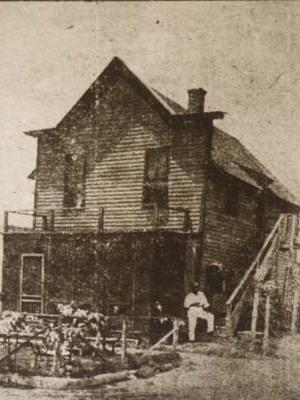
Greenwood, Okla.: The Black Wall Street
Courtesy of the Department of Special Collections, University of Tulsa
In the early 1900s, African Americans settled in Oklahoma , seeking employment and other opportunities in the rich oil fields. Greenwood, part of Tulsa , became home to thriving black businesses -- decades later earning it the moniker " Black Wall Street ." But in May 1921, Greenwood faced escalating racial unrest after a young white woman accused a black man of rape. The man wasn't charged, but that didn't stop a white mob from burning down Greenwood , the site of the worst race riot in U.S. history.
#7
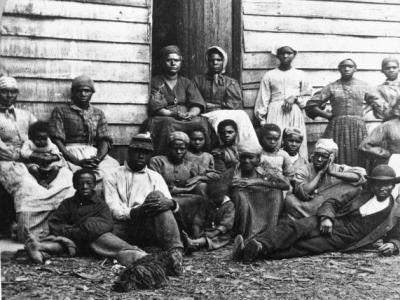
Freedman's Village, Va. : The Nation's Safe Haven
Getty Images
In 1863 the federal government built Freedman's Village on the grounds of the Custis and Lee estates. There were about 50 one-and-a-half-story houses, each of which was divided to accommodate two families. The settlement was home to some notable residents, including Sojourner Truth -- who in 1864 worked as a teacher and helped villagers find jobs. The government closed down the village in 1900. It is now the site of the southern end of Arlington National Cemetery , the Pentagon and the Navy Annex building.
#8
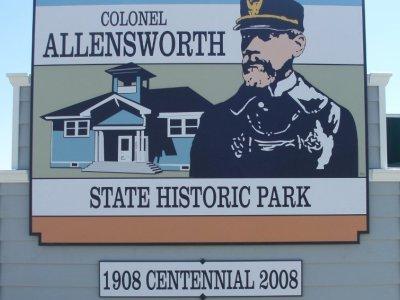
Allensworth, Calif. : A California Dream
Courtesy of Friends of Allensworth
In 1908 Lt. Col. Allen Allensworth and four others set up the California Colony and Home Promoting Association with the mind-set of establishing the state's first all-black . Located on the Santa Fe rail line, by 1914 the town housed the first black school district, a judicial system and a hotel. The town struggled to stay afloat in the face of setbacks, from water-supply issues to the railroad closing its stop there. The township is now preserved as Colonel Allensworth State Historic Park .
#9
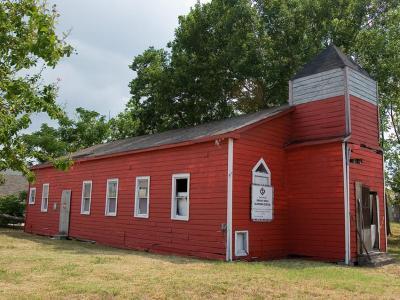
Freedmen's Town, Texas : Houston 's 'Little Harlem '
Courtesy of Texas Historical Commission
At the end of the Civil War, thousands of freed slaves purchased land and built their homes along the Buffalo Bayou, dubbing it "Freedmen's Town." And over six decades the town thrived, with churches, schools, stores, theaters and jazz spots lining the cobblestone roadways. By the 1920s it was known as "Little Harlem ," but the Great Depression caused many to lose their homes. Some longtime residents moved to other Houston neighborhoods; others stayed and watched the community deteriorate. In 1984 Freedmen's was designated a historic district.
#10
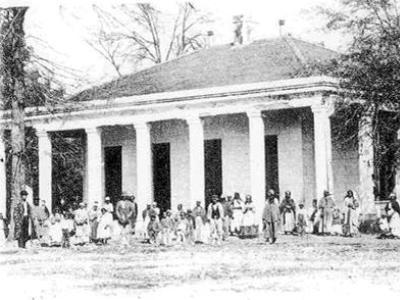
DavisBend , Miss. : A Progressive Slave Town
Courtesy of The Mississippi Historical Society
Davis Bend was a former plantation owned by Joseph Davis, who created a more self-governing community among his 350 slaves. Benjamin Montgomery, one of those slaves, served as the overseer. After the war, Davis sold the land on which his plantation was situated to Montgomery for $300,000 in gold; Montgomery maintained the free cooperative community until the 1880s. But the community fell victim to a poor economy and racial hostility. Montgomery 's son, Isaiah, established a new town, Mound Bayou, which exists today.
#11
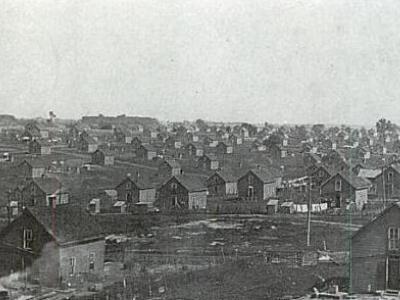
Muchakinock, Iowa: The Strike Breakers
Courtesy of The African American Museum of Iowa
From 1875 to 1900, Muchakinock was home to one of the nation's largest coal-mining firms, Consolidated Coal Co. In 1880 J.E. Buxton, superintendent at Consolidated, sent officials to recruit black laborers from Virginia and West Virginia . Black families settled into the town, but by 1900 the coal mines were exhausted and Consolidated started opening up new camps in Buxton , Iowa .
#12
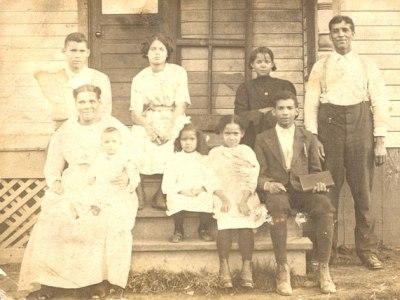
Buxton, Iowa: 'A Black Man's Town'
Courtesy of The African American Museum of Iowa
While it was a multiethnic community, Buxton was considered "a black man's town" because the number of African-American families significantly outweighed that of other ethnic groups. As in Muchakinock , Iowa , blacks held many key roles in town, including two justices of the peace and two deputy sheriffs. With a black population that reached about 5,000, the town was dubbed by Booker T. Washington "a success." But soon, demand for coal, the town's principal industry, began to lessen. By 1927 Buxton had lost all of its residents.
#13
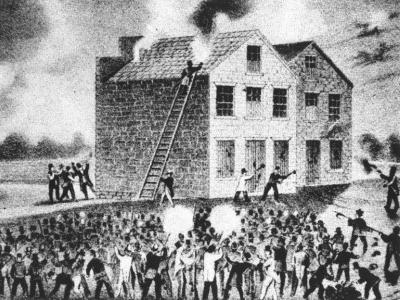
New Philadelphia, Ill. : A Pioneer Town in the Frontier
Courtesy of Illinois Historic Preservation Agency
Founded in 1836, New Philadelphia was among the first towns registered by an African American prior to the Civil War. Frank McWhorter, a former Kentucky slave, pulled together money from work and his own enterprises to purchase freedom for himself and his family and buy 42 acres in southwest Illinois . Before the Civil War, his town was a safe haven for the Underground Railroad. But the Hannibal and Naples railroad bypassed the town, and by the late 1880s, residents started leaving. Today New Philadelphia is an open field. It was named a national landmark in 2009.
#14
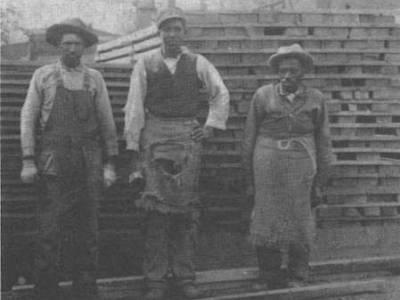
Pin Oak Colony, Ill. : Byproduct of the Northwest
Courtesy of The Forest History Society
Established in 1818, this small townships pread across just 480 acres. It was organized under the Northwest Ordinance of 1787, an act that led to Western expansion and excluded slavery. After the Civil War, many residents relocated to other towns.
#15
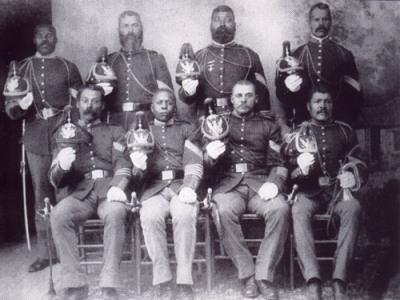
Blackdom, N.M.: The Black Ghost Town
Courtesy of the NAACP of Otero County New Mexico
Located southwest of Roswell , Blackdom, established by Frank and Ella Louise Boyer, was the first all-black settlement in New Mexico . The heyday for the town was around 1908, when there were about 300 residents. They had set up a post office, a blacksmith, stores, a hotel and the Blackdom Baptist Church , which also served as the schoolhouse. By the 1920s a severe drought led settlers to abandon the town.
|